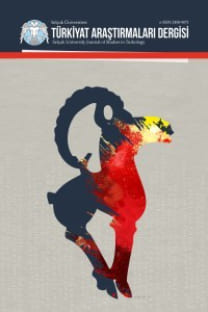Osmanlı-Türk Düşüncesindeki Doğu-Batı İmgelerini Küreselleşme Tartışmaları Bağlamında Yeniden Düşünmek
Osmanlı-Türk düşüncesinde Doğu ve Batı imgelerinin her birinin hangi referansçerçevelerinde ortaya konduğu ve bu anlamda küreselleşmenin uzun geçmişi olan ne türsorunlarının olduğu bu makalenin ilgi konusudur. Osmanlıda ilk modernleşme çabalarıylagirilen küreselleşme sürecinde Batı teknolojik üstünlüğünün yanında yayılmacı birkarakterle özdeşleştirilir. Batı bilimsel ve teknolojik üstünlüğü nedeniyle ulaşılmak istenenbir medeniyet düzeyini temsil etmesine karşın emperyalist amaçları nedeniyle engellenmesigereken bir gücü temsil eder. Bu bağlamda, Doğu, Osmanlı ve Türk imgelerininBatı yayılmacılığına karşı savunmacı bir nitelik gösterdiği görülmektedir. Sosyal bilimlerdekison dönem küreselleşme literatürü gözden geçirildiğinde, sorunların yeni olmadığınıiki yüzyıldır aynı sorunların uluslar arası uluslar arası olguları anlamada geçerliliklerinisürdürdüklerini görmekteyiz. Bu sorunlar temelde teknoloji, emperyalizm vekapitalizmin doğası ve işleyişi ile ilgilidir
Anahtar Kelimeler:
Osmanlı-Türk Düşüncesi, Doğu ve Batı İmgeleri, Küreselleşme, Emperyalizm
RETHINKING THE IMAGES OF EAST-WEST IN OTTOMAN-TURKISH THOUGHT IN THE CONTEXT OF GLOBALIZATION DEBATES
This article is concerned with the reference framework in which the images of East and West are put forth in the Ottoman-Turkish thought and in this sense the long lasting problems of globalization. In the Ottoman Empire, within the globalization process that begun with the initial efforts of modernization; the West was identified with a hegemonic character beside its technological superiority. On the one hand, because of its technological superiority West had represented a level of civilization that other nations wanted to reach at, on the other hand because of its imperialist goals it represented a power that had to be prevented. In this sense, it is seen that the images of the East, the Ottoman and the Turk mainly indicated defensive character against the Western expansionism. A review of the recent literature of globalization in social sciences shows that the problems are not new for the two centuries the same problems have been valid in understanding the international phenomena. These problems are mainly related to the nature and operation of technology, imperialism, and capitalism
- ISSN: 1300-5766
- Yayın Aralığı: Yılda 3 Sayı
- Başlangıç: 1994
- Yayıncı: Selçuk Üniversitesi
Sayıdaki Diğer Makaleler
Karşılaştırmalı Edebiyat Bilimi ve Bir Uygulama
XVI. Yüzyılın İlk Yarısında Kiğı Sancağı’nda İskan ve Toplumsal Yapı
Türkçede -ma (-me) Ekinin Yeri
Yaşar Nabi Nayır’ın Çeviriye Dair Görüşleri
Hâce Hatib Mahmud Er-Rûmî, Eserleri ve Osmanlı İlim Hayatındaki Yeri
